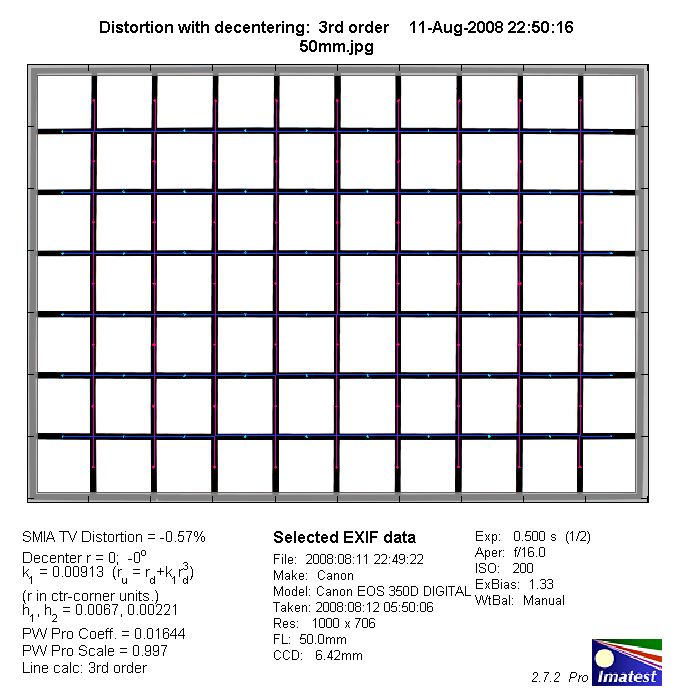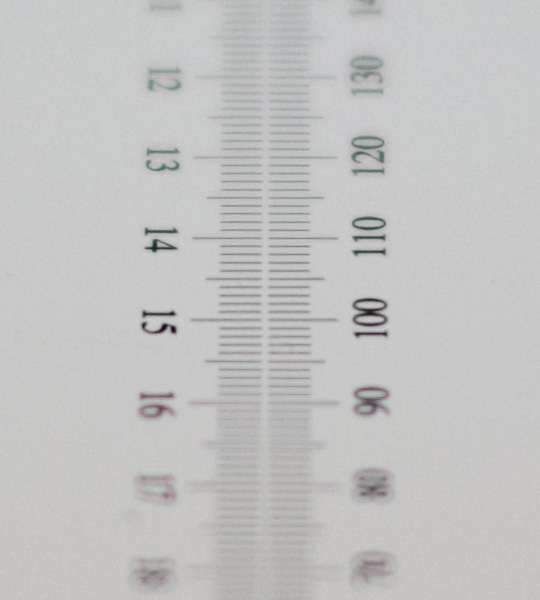|
Sigma AF 50mm f/1.4 EX DG HSM (Canon) - APS-C Review / Test Report - Analysis |
|
Lens Reviews -
Canon EOS (APS-C)
|
|
Page 2 of 2

Distortion
The Sigma produces a fairly typical degree of barrel distortion (0.6%) for a 50mm lens - this is usually not disturbing in field conditions.

The chart above has a real-world size of about 120x80cm. Note: we've reused the results from our initial test of the lens here.
Vignetting
As mentioned the Sigma has a fairly massive front element which is already an indicator for a very good vignetting characteristic - more so on APS-DSLR due to the sweet spot effect here. Within this scope the Sigma has a comparatively moderate vignetting of 0.8EV at max. aperture which can be visible at times. The problem is pretty much negligible from f/2 onwards.

MTF (resolution)
The Sigma produced very decent resolution figures in the MTF lab. At f/1.4 the center performance is very good whereas the borders follow a little behind on a good level. The center quality improves to excellent quality when stopping down to f/2.8. The borders reach very good levels at f/2 and there's only a slight improvement beyond. The field curvature is negligible.
In the field the lens has a few troubles at extremely close focus distances and large aperture settings - this is forgivable regarding the quite impressive performance at mainstream focus distances.
It's quite obvious that the lens has more trouble with the 15mp of the EOS 50D compared to our initial test based on the EOS 350D @ 8mp.
Please note that the MTF results are not directly comparable across the different systems!
Below is a simplified summary of the formal findings. The chart shows line widths per picture height (LW/PH) which can be taken as a measure for sharpness.
If you want to know more about the MTF50 figures you may check out the corresponding Imatest Explanations
Chromatic Aberrations (CAs)
Lateral chromatic aberrations (color shadows at harsh contrast transitions) are generally moderate with an average pixel width around 0.8px at the image borders.

Bokeh
The quality of the bokeh (out-of-focus blur) is a primary aspect for such a large aperture lens and the Sigma lens is capable of producing very decent results here. The rounded aperture shape in out-of-focus highlights remains intact all the way up to f/4. However, at f/1.4 there're also traces of onion-like structures. The general foreground and background blur can also be somewhat nervous at f/1.4 but this aspect is pleasing again from f/2 onwards.

Longitudinal (Axial) Chromatic Aberrations (LoCA)
LoCAs (non-coinciding focal planes of the various colors), sometimes called "bokeh CAs", are a general problem in this lens class. As you can notice below the halos have different colors - magenta (red + blue) in front the focus point and green beyond. The Sigma does a comparatively good job here though. The problem is visible but although not overly disturbing at f/1.4 and at f/2 it is usually not field-relevant anymore.
Upon closer observation you may notice that the focus shifts towards the back when stopping down ("Residual spherical aberrations") - especially from f/2 to f/2.8.
|
Move the mouse cursor over the f-stop marks below to observe the respective LoCAs
|
| f/1.4 |
f/2 |
f/2.8 |
f/4 |
|

|
Sample Images
You can find some APS-C sized sample images in the initial review of this lens.
Verdict
The new Sigma AF 50mm f/1.4 EX DG HSM is a refreshing alternative in the long-ignored standard AF lens market. The lens is fairly big and heavy due to unusually big glass elements but thanks to the design efforts it is already capable of delivering sharp images straight from f/1.4 and the resolution is impressive at medium aperture settings. However, expect some softer results at very close focus distances at large aperture settings. Distortions, vignetting as well as CAs aren't overly relevant in field conditions. The bokeh can be a bit nervous at f/1.4 but it's smoother from f/2 onwards.
The build quality of the lens is excellent. The HSM AF drive is very fast and virtually silent. Unfortunately the lens suffers from residual spherical aberrations (focus shifts) when stopping down which may spoil the game at times.
|